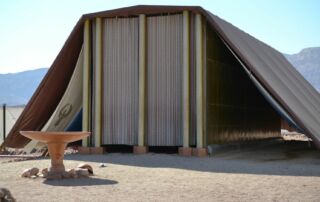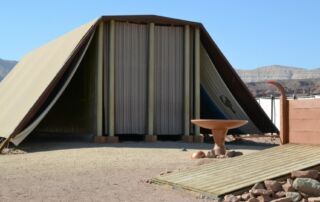The Tabernacle Prayer Plan: Part 2
If you haven’t read “The Tabernacle Prayer Plan: Part 1” yet, we encourage you to read that before continuing below.
THE TABLE OF SHEWBREAD
The brazen laver marked the separation of the outer court from the holy place, which was the inner tent within the tabernacle walls. The first item in the holy place was the table of shewbread–a ceremonial stand with twelve loaves of bread representing the needs of the twelve tribes of Israel. The priests ate the bread as a sign to the Lord that He was their source who would meet all of their needs.
The shewbread represents our physical needs, the Word as our food (Matthew 4:4, John 4:34) and Jesus as the Bread of Life (John 6:35). When we enter God’s presence, we should be hungry for revelation and eager to feed on His Word.
Remember the travelers on the road to Emmaus? “Now it came to pass, as [Jesus] sat at the table with them, that He took bread, blessed and broke it, and gave it to them. Then their eyes were opened and they knew Him; and He vanished from their sight” (Luke 24:30-31). When we open our Bibles and feed on God’s Word, we should expect to see Jesus, to sense His presence in every passage and teaching. His presence sustains us. The writer of Hebrews says, “The Son is the radiance of God’s glory and the exact representation of his being, sustaining all things by his powerful word” (v. 3 NIV, emphasis added).
None of us would dream of going days without food. God is telling us that we need to regularly feed on His Word. This is what will sustain us through each season of our lives.
THE GOLDEN CANDLESTICK
Next to the table of shewbread was the golden candlestick with one long branch in the middle and three offshoots on each side. Unlike our candlesticks today, the golden candlestick didn’t hold wax candles, but oil, much like a lamp.
The priests kept the golden candlestick lit to provide light for both the holy place and the holy of holies, so they could see and obey the Lord in their service. Remember, light, flame, and oil all represent the presence of the Spirit of the Lord, which should constantly be burning in us.
The golden candlestick reminds us to never let the flame of the Holy Spirit grow dim in our lives so we can see what God is doing and constantly burn bright, lighting up our lives for the glory of God. Paul encouraged Timothy “to fan into flame the gift of God, which is in you . . . “ (2 Timothy 1:6 NIV). Likewise, we should seek out the Spirit of God in our lives and watch for His presence in all that we do. When we are in touch with His presence, we shine brightly in the world. We become the golden candlestick that illuminates situations and brings understanding to others.
One day, we will see the seven golden candlesticks blazing before the throne of God Almighty. Our daily prayer should be to keep the Spirit of God alive in our lives so that we can clearly see His path and His direction in serving others.
THE ALTAR OF INCENSE
The last piece of furniture in the holy place was the altar of incense. The incense was continuously burning, filling both the holy place and the holy of holies with a sweet aroma that attracted God’s presence. For the people of Israel, this incense, made from a very special combination of spices and oils, was a symbol of intercession.
At the altar of incense, the priest would intercede for the people. The altar was lit with coals from the brazen altar, reminding us that our prayer must come humbly before God with an understanding of both our sin and the sacrifice that Jesus made.
There were several times when “strange fire” (this was any fire that didn’t come from the brazen altar) was used to light the altar of incense. Each time, God severely judged those who didn’t follow His instructions.
Prayer Plan: The altar of incense represents how our High Priest, Jesus, is always interceding before God on our behalf (Hebrews 7:25). When we pray, we should put the needs and requests of others before our own. When you pray for other people, your words to God on their behalf can have a powerful impact on their lives. Letting others know you are praying for them is a great encouragement when they are going through a dark time. These prayers of the saints are like incense, having a sweet aroma to God that pleases Him (Revelation 5:8).
THE ARK OF THE COVENANT
After going through the outer court and the holy place, the priest would enter the holy of holies–the place where only the high priest could go before the Lord, and then, only with an offering of blood. Here was where you would find the ark of the covenant, which had two pieces. The bottom piece was a container where the Ten Commandments, the golden pot of manna, and Aaron’s budding rod were kept. The golden pot of manna symbolized God’s supernatural provision for His people, the budding rod demonstrated His delegated authority through human leadership, and the Ten Commandments represented His truth.
Prayer Plan: When you come before the Lord in prayer, ask for His provision. That’s what Jesus did. His model prayer included the simple request for daily food. Relying on the Lord for our daily needs is a way of expressing our humility, showing that we rely on Him for all things.
Praying for people in authority is a practice encouraged by the apostle Paul, a man whose native country was occupied by a foreign army. When we are in the holy presence of God, we can find the spiritual strength to pray for our enemies and those who may be abusing their power over us. Wise leaders also need our prayer support because they are constantly under attack from the enemy.
Finally, the truth of God’s commands is the way to freedom. Therefore, pray in spirit and truth, seeking the truth about yourself and your situations, and asking for truth to be revealed.
THE MERCY SEAT
The second, or top, piece of the ark was called the mercy seat. It was made of pure gold and fashioned with two cherubim guarding the throne. The presence of God, in the form of a pillar of cloud by day and a pillar of fire by night, hovered over the mercy seat between the two cherubim.
On the Day of Atonement, the high priest would sprinkle blood on the mercy seat for the remission of sin. Here God would speak to the high priest and give him instruction and guidance for all of the people. The message of the holy of holies? God relates to you in mercy and truth. We need mercy from God to overcome problems, difficulties, and enemies. But we also have attitudes, character flaws, and areas we need to change, so we need truth.
Prayer Plan: When you come before God in His presence, He’s not going to play around and ignore the issues He has asked you to change. But when He knows you are listening and that you’ll embrace truth, then you will not only experience His mercy, but enjoy it as well.
——
For more on this topic, click here.



